
Why does this matter?
Named apple cultivars, like 'Northern Spy' or 'Mcintosh', are propagated by cloning: branches or buds from existing trees are grafted onto rootstocks or branches of other apple trees. This means that all individuals of a given cultivar are genetically identical (more or less), which is what allows us to identify them.
On the other hand, apple seeds are usually NOT genetically identical to either of their parents, and are normally a cross between two different trees. Trees that grow from a seed are traditionally called "pippins", and each one is genetically unique. If your tree came up from such a seed, rather than being grafted, we won't be able to identify it for you, although we might be able to identify possible parents for it.
How can I tell?
Clues that your tree is a named cultivar include it's location (e.g. planted in rows in an old orchard) or some knowledge of the tree's history that suggests it was intentionally cultivated. You may also be able to detect a graft point low on the tree's trunk, although this is can be difficult to see in older trees. Cultivar trees will usually have a large, central trunk with either no secondary stems starting at ground level or only relatively small ones (probably from rootstock). Multi-stemmed trees are usually pippins.
Please see the Cultivars and Ferals page for details about these distinctions, and about the limits of what our testing can tell you.
Step 2 : Collect some leaves
We will need two small to medium-sized leaves.
The best time to collect these is in the spring when they are actively growing (May and June), but as long as they are collected before they start to change colour in the fall, there's a good chance that they'll be OK.
Avoid collecting leaves from branches that start near to the ground. These might be shoots coming from a rootstock.
Keep the leaves out of the sun after collecting them and try to keep them from getting too warm.
Step 3 : Dry the leaves
Step 4 : Tell us about your tree
Collect some information about your tree. Where is it located? What do you know about its history? How big is it? What are the fruit like?
Fill out an information form. This is a fillable form; you should be able to type information right into it, save it, and email it to us when you're ready to send your samples (Step 5). Information form.
Send us some photos! Although these are not strictly required, they can provide helpful information.
How to dry your leaves
The best results are achieved when leaves are dried quickly at room temperature or cooler. DO NOT USE A WARM AIR DESICCATOR OR OVEN!
The best way to dry your leaves is with a commercial desiccant such as silica gel beads. These are often sold at craft stores for drying plant material.
Step 5 : Send us your leaves
• Place your dried leaves in a small envelope or a folded up piece of paper, label it, and place it inside an envelope or card.
• Send it to us by regular mail at the address below
• Email Paul at pkron@uoguelph.ca to let us know that it's coming. Ideally, attach your information form to the email, but if you prefer, you can print it out and mail it with your sample.
We'll do the rest!
Paul Kron
Room 1409, Summerlee Science Building,
University of Guelph,
50 Stone Rd E.,
Guelph, Ontario, Canada,
N1G 2W1
What will this cost?
The fee for 2023 is $40 (higher if outside Canada). Please don't send payment with your sample; you will be sent a bill later.
If you would like to contribute more than the required fee, please consider making a donation.
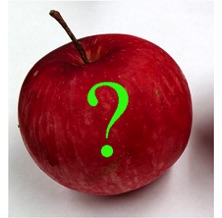
Step 1 : Try to confirm that your tree is a cultivar
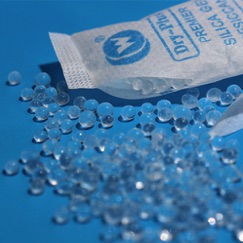
Silica gel desiccant
Put your leaves in a closed container with the desiccating material. Keep the leaf from direct contact with the desiccant, for example, by placing it in a small envelope, a folded piece of paper or a reusable tea-bag. Keep at room temperature or in the fridge until the leaves are dry (will crack if you bend them in half). This should take 1 to 3 days. See our detailed instructions.
What if I don't have silica gel desiccant?
Silica gel desiccation produces the best results, but if you have trouble accessing silica gel, here are some options:
Drop off or pick up of fresh leaves: If you live in the Guelph area, we may be able to arrange to pick up fresh leaves from you, or to have you drop them off at the university.
Drying with salt: Follow the instructions for silica gel desiccant drying, but use salt instead. Dry the leaves for about a week. They won't dry as quickly, and may discolour, but they should be fine. Avoid having the leaves directly touching the salt.
Drying in a book: Place leaves between two pieces of paper or newsprint and put between the pages of a book. Keep the book at room temperature and let the leaves dry for at least a week. Make sure the leaves are reasonably dry when you put them between the pages (i.e. not covered with rain or dew).

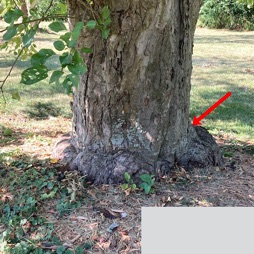
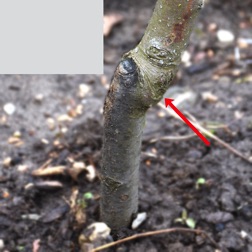
Graft point on young tree
Graft point on old tree
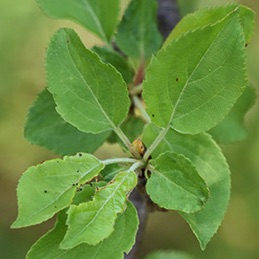
Photos of the fruit are especially useful, especially if we suspect that your tree is an unusual cultivar that we don't yet have in our genetic library. Any photo of the fruit is good, but the image here is an example of an ideal photo showing the colour, size and shape of the fruit.
You can send us your leaves in the spring or summer and send a fruit photo later.
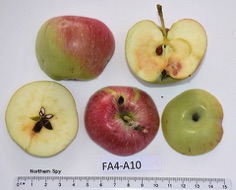
Testing has now been suspended. These instructions will be removed soon.
